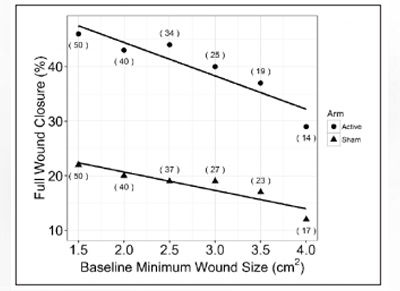A Prospective, Randomized, Double-Blind Multicenter Study Comparing Continuous Diffusion of Oxygen Therapy to Sham Therapy in the Treatment of Diabetic Foot Ulcers

Mark Q. Niederauer, PhD1, Joel E. Michalek, PhD2, and David G. Armstrong, DPM, MD, PhD3
Abstract
Background: Over the past generation, preclinical data have suggested that there is a potential physiologic benefit to applying oxygen topically to wounds. However, we are unaware of any studies in the literature that have robustly assessed whether this would lead to a higher proportion of healing in similarly treated people without oxygen. Therefore, the purpose of this study was to assess this in people being treated for chronic diabetic foot ulcers (DFUs).
Methods: We enrolled and randomized 100 subjects with DFUs (79% male, aged 58.3 ± 12.1 years) to receive either active continuous diffusion of oxygen (CDO) therapy using an active CDO device, or an otherwise fully operational sham device that provided moist wound therapy (MWT) without delivering oxygen. Patients were followed until closure or 12 weeks, whichever was sooner. Patients, treating physicians and independent evaluators were blinded to the study arm. All patients received identical offloading, dressings and follow-up.
Results: There were no significant differences in assessed descriptive characteristics between the treatment arms (P > .05 for all). A significantly higher proportion of people healed in the active arm compared to sham (46% vs 22%, P = .02). This relative effect became greater in more chronic wounds (42.5% vs 13.5%, P = .006). Patients randomized to the active device experienced significantly faster rates of closure relative to the sham (P < .001).
Conclusions: The results of this study suggest that continuously diffused oxygen over a wound leads to significantly higher rates of closure, and faster time to closure, compared to similarly treated patients receiving standard therapy coupled with a sham device. Furthermore, the relative efficacy appears to improve the more the therapy may be needed (more chronic and larger wounds).
